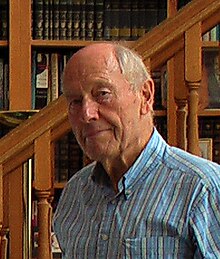David W. Allan

David Wayne Allan | |
|---|---|
 Allan in August 2014 | |
| Born | September 25, 1936 Mapleton, Utah, United States |
| Known for | Allan variance |
| Awards |
|
| Scientific career | |
| Fields | physics |
| Institutions | National Institute of Standards and Technology |
| Website | allanstime |
David Wayne Allan (born September 25, 1936) is an American atomic clock physicist and author of the Allan variance, also known as the two-sample variance, a measure of frequency stability in clocks, oscillators and other applications.[2] He worked for the National Bureau of Standards in Colorado.[4]
Allan was born in Mapleton, Utah, on September 25, 1936. He studied physics at the Brigham Young University (B.S. 1960) and the University of Colorado (M.S. 1965).[5] From 1960 to 1992, he was a physicist in the Time and Frequency Division of the National Institute of Standards and Technology (then the National Bureau of Standards) in Boulder, and from 1979 was 1988 chief of the Time and Frequency Coordination Group.[5] He retired in 1992 and lives in Fountain Green, Utah.[5] After retirement, he consulted for Hewlett Packard from 1993 to 1997. While there, he contributed to "The Science of Timekeeping,[6] which documents his contributions to the nation as a timekeeper- generating time from an ensemble of atomic clocks and from the nation's primary frequency standard at NIST/NBS.
Allan was a consultant for the United Nations Development Programme in New Delhi in 1981 and a guest scientist in the People's Republic of China in 1982.[5]
He is a member of the Church of Jesus Christ of Latter-day Saints.[4] He has been married since 1959.[5]
Awards
[edit]Allan received the Silver Medal of the Department of Commerce in 1968 and one of the IR-100 awards of Industrial Research magazine in 1976.[5] He received the Rabi Award of the IEEE Ultrasonics, Ferroelectrics, and Frequency Control Society in 1984.[1] In 1999 he was named an honorary fellow of the Institute of Navigation.[4] In 2018 he received the Joseph F. Keithley Award in Instrumentation and Measurement of the Institute of Electrical and Electronics Engineers.[3]
In 2016, the IEEE celebrated the 50th anniversary of the publication of Allan’s master’s thesis, giving birth to the Allan variance.[7] He was given an achievement award with the citation: “For seminal work… time determination, time prediction, time dissemination, and timekeeping through contributions to atomic frequency standards, space-based navigation, time and frequency stability analysis, time-scale algorithms, and timekeeping devices.” His 2018 Keithly Award citation read, “Leadership in time determination and precise timing instruments.” In 2021, the IEEE made him an IEEE FELLOW. Because of his work, in 2018, the IEEE made an ORAL history[8]
He was given an achievement award with the citation: “For seminal work… time determination, time prediction, time dissemination and timekeeping through contributions to atomic frequency standards, space-based navigation, time and frequency stability analysis, time-scale algorithms, and timekeeping devices.”
References
[edit]- ^ a b IEEE UFFC - Frequency Control - Awards - Rabi Award. Institute of Electrical and Electronics Engineers. Archived 5 October 2016.
- ^ a b "2011 - David Allan". International Timing & Sync Forum. Archived from the original on 22 May 2019. Retrieved 5 October 2014.
- ^ a b IEEE Joseph F. Keithley Award in Instrumentation and Measurement Recipients. Institute of Electrical and Electronics Engineers. Accessed October 2020
- ^ a b c "Portraits - Ensign Jan. 2000 - ensign". Retrieved 24 November 2016.
- ^ a b c d e f Katherine H. Nemeh (editor) (2014). American Men & Women of Science: A Biographical Directory of Today’s Leaders in Physical, Biological and Related Sciences, 32nd edition, volume 1. Detroit: Gale Cengage Learning. ISBN 9781414496498. (subscription required).
- ^ "The Science of Timekeeping" (PDF). Retrieved 20 July 2024.
- ^ "Introduction to the Special Issue on Celebrating the 50th Anniversary of the Allan Variance". Retrieved 20 July 2024.
- ^ "Oral-History:David W. Allan". Retrieved 20 July 2024.